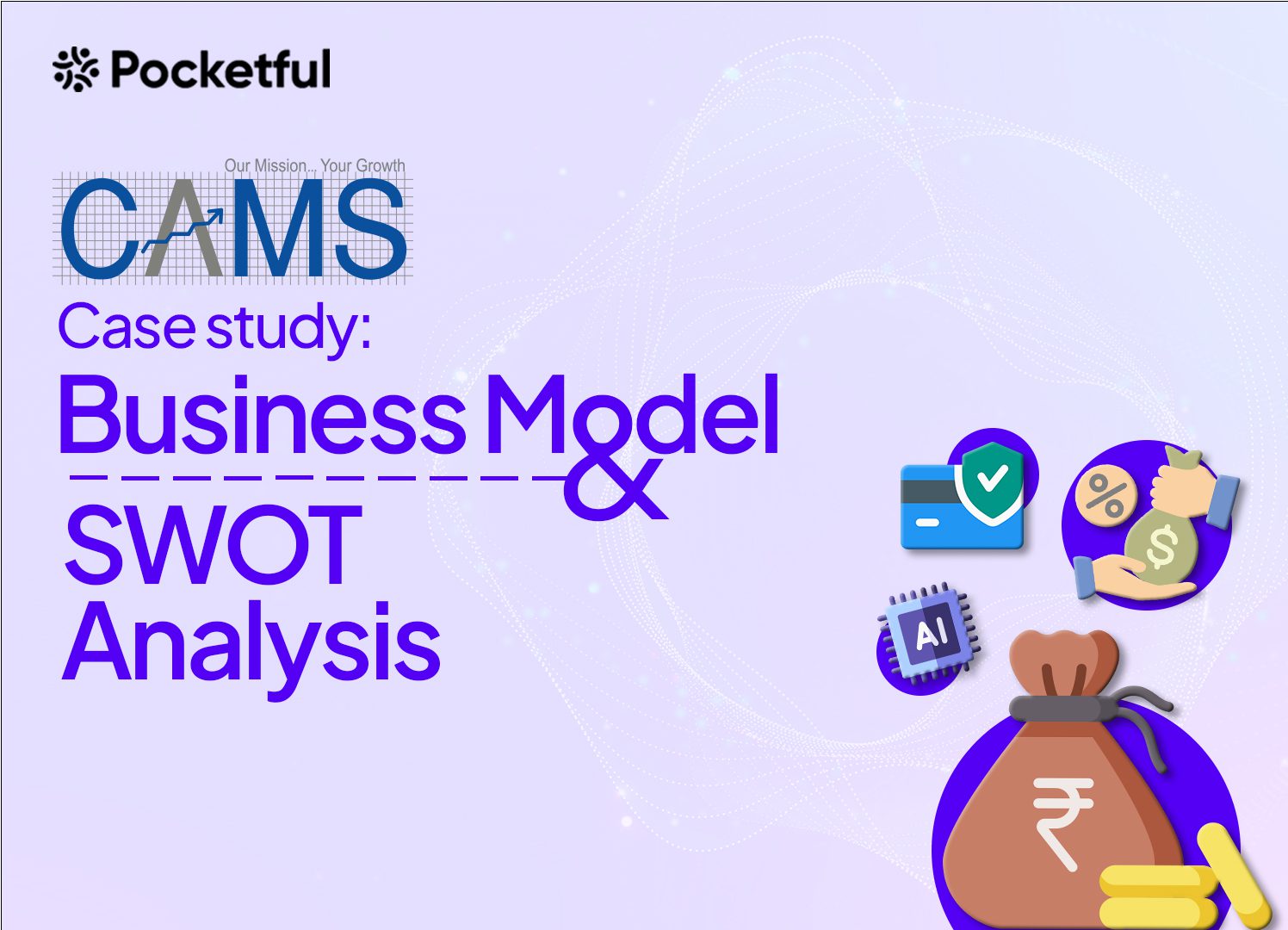| Type | Description | Contributor | Date |
|---|---|---|---|
| Post created | Pocketful Team | Mar-05-24 | |
| Add new links | Nisha | Apr-11-25 |

- Blog
- cams case study business model kpis and swot analysis
CAMS Case Study: Business Model, KPIs, and SWOT Analysis

While investing money may seem like a simple task, it’s more complex than you may think.
We will introduce you to a company in today’s article that manages the backend operations of practically all investments made through mutual funds. It’s a highly laborious operation!
Overview of CAMS
When V Shankar launched CAMS in 1988, the company was primarily focused on software development.
The company later obtained a significant investment in 2000 from the HDFC Group, and in 2014, it obtained more funds from the National Stock Exchange (NSE). The business rose to the industry’s top by offering registrar and transfer services to the mutual fund sector.
Subsequently, the corporation added other services to its list of offerings, including electronic payment services, KYC, insurance repository, and account aggregation.
By working with more than 750 institutions, the company expanded significantly and was able to secure a market share of more than 70% in the mutual fund transfer industry.

Do you know what RTA is?
The entity that manages a company’s ownership records of shareholders and bondholders is known as the Registrar and Transferer (RTA). It makes it easier for units to be transferred between holders.
Awards and Recognitions
2023 – Economic Times Datacon Award
2023 – Technoviti Awards 2023
2020 – Excellence Awards in BFSI – Technology by ASSOCHAM
2019 – Business World Top 1000 companies
2018 – Emerging Company Award by Economic Times

Quick facts
1. CAMS maintains a record of roughly 17 million investors.
2. Out of the 48 trillion assets in the business, they represent 33 trillion assets.
3. They hold a market share of roughly 69% of the assets in the mutual fund sector.
Market Capitalization
As of 11 February 2024, the current market capitalization of CAMS is 14,955 Crores.
Current Share Price
As of 11 February 2024, the share price of CAMS is 2905.
Shareholding Pattern
In the most recent quarter, promoters saw a fall in their stake from 19.87 to 0, while FIIs and DIIs increased their holdings from 38.61% to 47.69% and 16.06% to 23.08%, respectively.
Read Also: BSE Case Study: Business Model And SWOT Analysis
Business Model and Marketing Strategy
CAMS offers services to mutual funds, banks, insurance companies, and other financial institutions, including account opening, account maintenance, transaction processing, dividend distribution, and all forms of investor communication.
Transaction fees, which they charge for each account opening, transaction processed, dividend payout, etc., are their primary source of income. In addition, they impose fixed account charges based on the quantity of accounts they administer. Additionally, they also collect monthly fees for their add-on services.
Financial Highlights of CAMS
Let’s examine its annual income statement to gain further insight into the company’s financial performance.
| Particular | 31st March 2023 | 31st March 2022 | 31st March 2021 |
|---|---|---|---|
| Total Revenue | 972 | 910 | 706 |
| Total Expenses | 551 | 486 | 409 |
| Profit before tax | 380 | 383 | 274 |
| Profit after tax | 285 | 287 | 205 |
Based on the financial statistics presented above, it is evident that the company’s finances are growing steadily. Both revenue and profit are consistently rising.
Let’s now examine the balance sheet of CAMS to see its financial situation.
| Particular | 31st March 2023 | 31st March 2022 | 31st March 2021 |
|---|---|---|---|
| Non-Current Assets | 367 | 339 | 309 |
| Current Assets | 730 | 618 | 533 |
| Non-Current Liabilities | 147 | 135 | 139 |
| Current Liabilities | 168 | 173 | 186 |
We will now require you to review the company’s cash flow statement.
| Particular | 31st March 2023 | 31st March 2022 | 31st March 2021 |
|---|---|---|---|
| Cash flow from operating activities | 319 | 321 | 264 |
| Cash flow from investing activities | (102) | (131) | 2.16 |
| Cash flow from financing activities | (205) | (203) | (272) |
| Net Increase/Decrease in Cash Activities | 12 | (12) | (.58) |
The statistics above make it evident that net cash flow is now positive after two years of negative figures.
Key Ratios
| Particular | 31st March 2023 | 31st March 2022 | 31st March 2021 |
|---|---|---|---|
| Net Profit Margin (%) | 28.6 | 31 | 31 |
| ROCE (%) | 43.52 | 52.37 | 47.70 |
| Y-o-Y Sales Growth (%) | 18.49 | 15.16 | 5.45 |
Net Profit Margin – This ratio indicates the profit margin as a percentage of revenue.
ROCE – It refers to the financial ratio that defines a company’s profitability from the capital that it uses.
Y-o-Y Sales growth – This defines the increase in company’s sales over a year.

SWOT Analysis
Strengths
- The business has a long history of great brand recognition and is well-known in the sector for its inventiveness, security, and dependability.
- They have excellent stability options and can manage big data, both advantageous for expanding businesses.
- Millions of investors’ sensitive data is protected from cyberattacks and unwanted access by CAMS’s highly advanced security system.
Weaknesses
- The Indian market accounts for most of CAMS’s revenue; nevertheless, their performance may be impacted due to the company’s restricted geographical coverage and related regulatory risk.
- Any downturn in this sector could affect CAMS’s performance, as the Indian mutual fund business provided the majority of its revenue.
- Due to its strong market position in India, any new competitors will affect its market share.
Opportunities
- As the population grows, so does the financial sector in India, and this expansion of the financial industry will help drive corporate growth.
- In the upcoming years, the corporation can broaden its global reach to reduce the risk of becoming overly dependent on the Indian market.
- Due to its strong market position in India, any new competitors will affect its market share.
Threats
- Since their reliance on technology grows daily, any cyber risk could hurt their business operations and reputation.
- The company works in the financial industry. Therefore any changes to government regulations will affect its operating and compliance costs, which will ultimately affect its profit margins.
- Any economic downturn can potentially affect investors’ investment decisions and, in turn, their businesses.
Read Also: IRFC Case Study: Business Model, KPIs, Financials, and SWOT Analysis
Conclusion
CAMS’s market position in the Indian mutual fund industry is approximately 70%, thus undeniably limited in scope. Nevertheless, the company is growing by diversifying its range of products. It’s also important to keep an eye out for the company’s declining promoter holdings, even though revenue and profit are rising.
We have covered every facet of the company in this CAMS case study, from its strengths to its weaknesses. Still, before we wrap up, we would like to encourage you to always think about your risk tolerance and time horizon before making any kind of investment.
Frequently Asked Questions (FAQs)
Who is the owner of CAMS?
HDFC Group and the National Stock Exchange own CAMS.
Can I track my mutual fund investment through CAMS?
Yes, you can track your mutual fund investment under CAMS; they provide a platform called CAMS online to check your mutual fund portfolio.
Do CAMS have a bright future?
Yes, the mutual fund business has a bright future based on its growth and the fact that CAMS holds approximately 70% of the market share.
Is CAMS an Indian company?
Yes, CAMS is an Indian company founded in the year 1988 by V Shankar.
Have FIIs increased their stake in CAMS?
Due to their strong optimism over CAMS’s future, FIIs have grown their share from 38.61% to 47.69% during the past month.
Disclaimer
The securities, funds, and strategies discussed in this blog are provided for informational purposes only. They do not represent endorsements or recommendations. Investors should conduct their own research and seek professional advice before making any investment decisions.